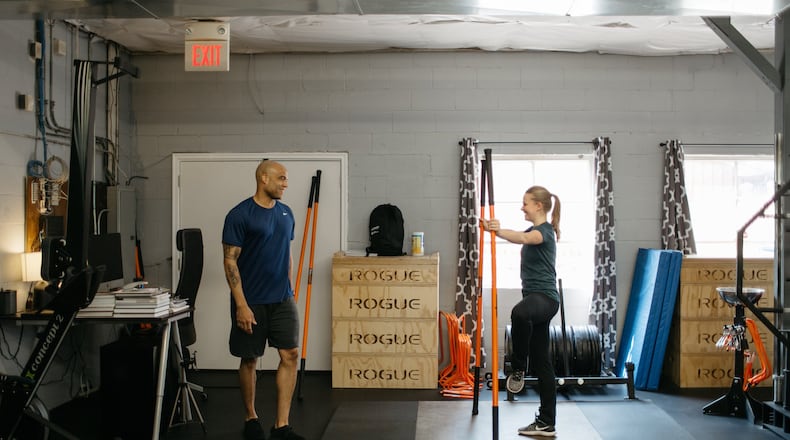After graduating from Ohio State, he got a job with the Central Intelligence agency as an analyst. Then he moved to New York in 2006 to become a writer, giving up the 9-5 life to “think deep thoughts,” he said. He started working as a personal trainer to make ends meet, and when the writing career didn’t take off, he turned training into his full-time job.
» CORONAVIRUS: Complete coverage
Eventually, Jason and his wife Susan, who are both graduates of Wayne High School, moved back to Dayton to be closer to family and opened Present Tense Fitness in the Oregon District in 2016.
The business was doing well and even expanded earlier this year, taking over the other half of its building at 222 E. Sixth St. to offer semi-private training. Now, like most small businesses in downtown Dayton, around Ohio and the country, Present Tense Fitness is trying to adapt and survive during the coronavirus pandemic.
“We decided to close just before the state mandated it,” Harrison said. “I sort of woke up on the weekend one morning and sent an email to everyone telling them what kind of precautions we were taking, and by the end of that night, I decided all the precautions were really justifications for trying to stay open, and I didn’t want to be responsible. Then we sent a note out saying we’re closing down. Then the state ended up closing everybody down anyway.”
» MORE COVERAGE: How respiratory therapists are leading the fight against COVID-19?
After Gov. Mike DeWine’s stay-at-home order was issued March 15, Harrison spent about a week focusing on his existing clients, writing home programs for them that take into account the various types of equipment they have at home.
Then Harrison filmed 25 home workouts anyone can watch for free on YouTube. The videos last from two to six minutes and show Harrison working out with little or no equipment.
“Our whole reputation is staked on the idea that what we coach people to do is the most efficient and most effective way of going about things,” Harrison said, “so when people are at home with nothing, that makes it more complicated. At this stage, I’m trying to think through how Present Tense Fitness can actually deliver things online that work for people. That’s kind of where we are now. We’re trying to make sure our clients are taken care of. My assumption is this is going to be the state of things for several months. I can’t just wait for the gym to open back up. The gym has to exist in this actual reality right now.”
Until the gym can reopen, Present Tense Fitness will rely on people who continue to pay for remote programming, which is different from the videos available on YouTube. These are workouts written specifically for the customer. One new online service, for example, is specifically written for pregnant and postpartum women.
» STILL RUNNING: Dayton RTA takes pride in continuing operations
"Not every person has the same goals, experience, or injury history," reads an explainer on the Present Tense Fitness website. "Our remote programming accounts for that by incorporating a detailed process intended to get to know you as a person so we can write workouts for you that fit into your actual life using the equipment (if any) to which you have the most realistic access."
In addition to Jason and Susan, the gym’s co-owners, Present Tense Fitness employs one other person: Anna Shearer, a personal trainer who also teaches yoga.
“She set up day one on Zoom, teaching her clients from home, which is a big relief,” Harrison said. “That allows her to keep income coming in. That was kind of the first priority. We are proud to make that happen.”
Present Tense Fitness also connects with people through its blog on dancer fitness. Harrison said it's read by dancers all over the world.
“That gives us an opportunity to then come up with services we can potentially sell to a global audience,” Harrison said. “Now that takes time. But it does give us an opportunity to ramp those things up. Normally my day starts at 7 a.m., and I leave the gym at 9:30 p.m. Most of that time is spent with people in front of me. I don’t have those people in front of me now, so it gives me time to think through that stuff.”
About the Author

